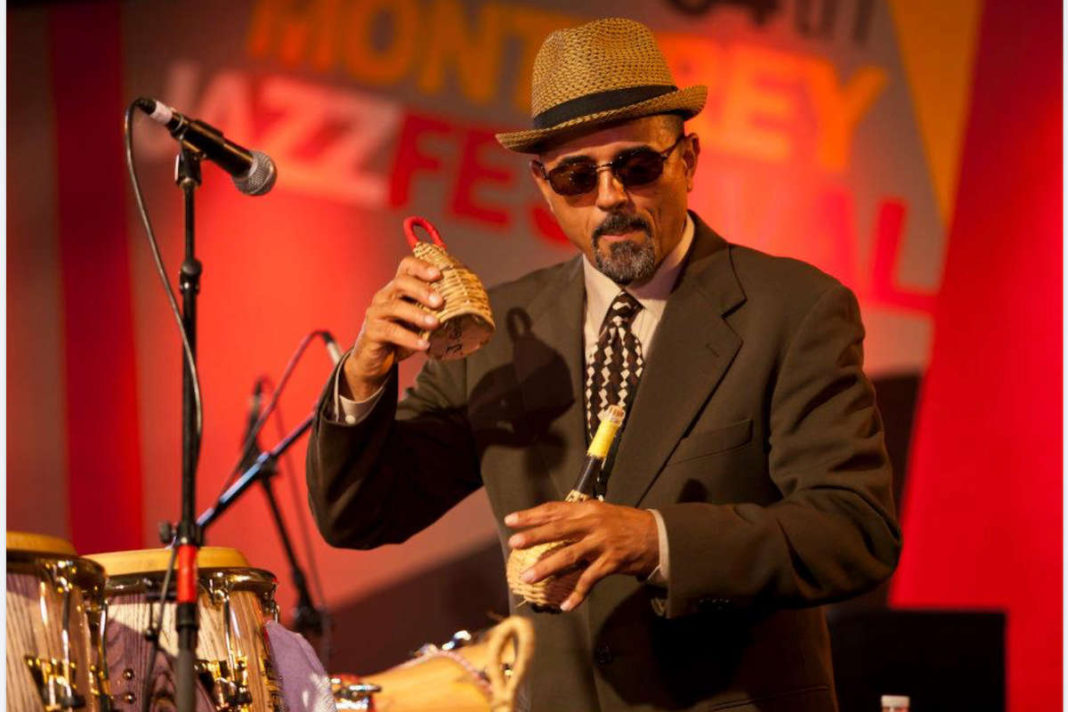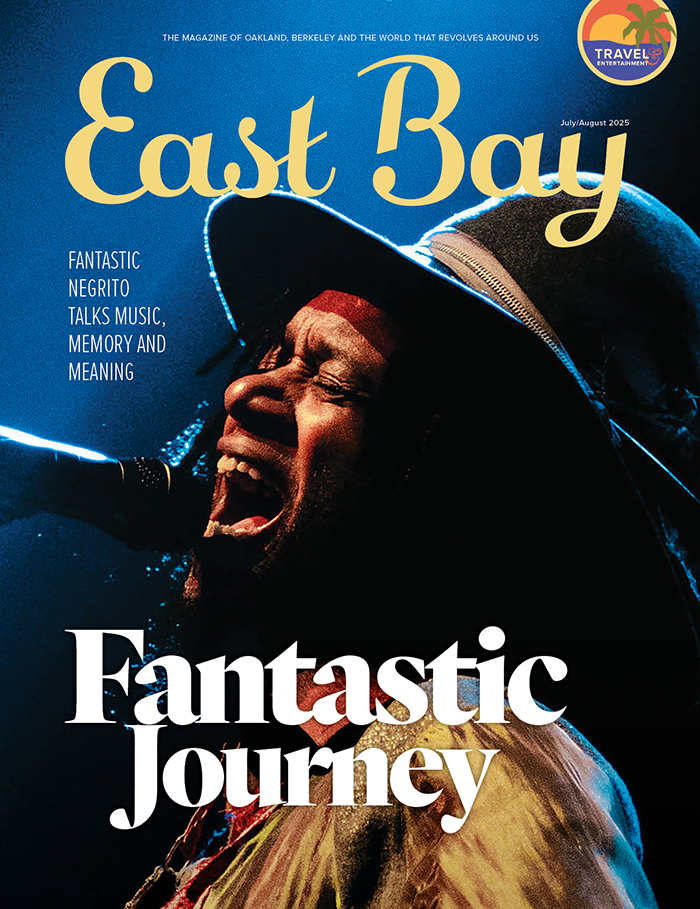John Santos has been playing congas, cajón, timbales and dozens of other percussion instruments for most of his life. The Bay Area’s music scene would not be as rich and varied as it is without his input. He calls his style Afro-Caribbean, rather than the more familiar terms, Afro-Cuban or Latin music.
“Saying ‘Latin music’ is akin to saying ‘jazz,’” Santos said, from the Oakland home he shares with his wife, the writer Aida Salazar, and their two children. “When we try to categorize the music by one term, it limits it. My music has a wide range. We have the folkloric element of different Afro-Cuban and Afro-Puerto Rican styles, the dance music element, which also has many varieties: danzón, mambo, rumba. Then you have more experimental and contemporary expressions, from funk to hip-hop, as well as different styles of jazz and the whole romantic element of poetry in ballads and boleros.
“The term Afro-Cuban was used in the ’40s and ’50s to describe the music, mainly coming from New York City, but other places as well. Over the years, with the influence of every country in Latin America and the Caribbean coming into the mix, the term is not accurate to express the kind of music we make,” he continued.
Santos’ eclectic approach is evident on Vieja Escuela, his new album with the John Santos Sextet. The title translates as “Old School” and pays homage to the older generation of players, using traditional rhythms as a foundation. It includes four legendary players—singer Ernesto Oviedo, composer and tumbadoras player Raul de la Caridad Gonzalez Brito, trumpeter Jerry Gonzalez and bongo master Orestes Vilató. Since the recordings were made, everyone but Vilató has passed on.
The album is out on Machete Records, the indie label Santos started in 1984. “I’ve never had outside funding, and I’m constantly writing, as are the other members of the band,” Santos noted. “When I get some extra money, I go into a studio and record. When elders or mentors come to town, I’ll bring them into the studio and record with them, or have them add to something we’ve already recorded. We record at a higher rate than what I can put out, so I end up stockpiling tracks. Much of this music was done well over a decade ago.”
Vieja Escuela lives up to its title, with seven tunes that cover the band’s wide range. “Esta Rumba Si,” written by Raul Gonzalez Brito, features the piano of Marco Díaz, supporting the multi-layered percussion tracks laid down by Santos, Gonzalez Brito and the Sextet’s Dave Flores. The lyric nods to the rumba’s African and Cuban roots.
Nuyorican icon Jerry Gonzalez adds his trumpet fills to “That Walk,” a Santos composition. It combines jazz, poetry spoken by Rico Pabon and a subtle bata rhythm. “Lago Xochimilco” is a mellow danzón/mambo, by bass player Saul Sierra, that shifts between 4/4, 5/4 and 6/4 time, allowing the band to show off its instrumental chops.
Santos contributed informative liner notes that delve into the musical, political and historical nuances of the music. Those insights make the music come alive in a stimulating way. “People have been asking me to write a book about the connections between Africa, Cuba, the Caribbean and the Bay Area for 30 years,” he said. “I don’t know how to type, and between gigs, composing, practicing, raising two teenagers and teaching, it would be hard to find the time to write.”
Since he grew up surrounded by music, it seemed inevitable that Santos would become a musician. “I was banging on pots and pans at home, inspired by the music my relatives played at family gatherings,” he recalled. “I started playing congas, emulating the guys in my granddad’s band. Then, a Cuban family moved in across the street, and the dad gave me a copy of Mongo Santamaria’s Yambu.”
Listening to the album was a life-changing experience. Santos began experimenting with timbales, bongos and other percussion instruments. He was sitting in with his grandfather’s band when he was 12. After that, he joined La Orquesta Tipica Cienfuegos and got them to rehearse until they were smoking.
They morphed into Orquesta Batachanga, mixing Afro-Cuban folkloric and dance music, with flavors from Puerto Rico and Brazil. They made two albums, La Nueva Tradición (1981) and Mañana Para Los Niños (1984), which was the first release for the Machete Records label Santos had started, then played a couple of concerts and broke up.
Next up was the Afro-Cuban Jazz Ensemble, a band that wrote, composed and arranged original music and played Afro-Cuban classics. After changing the name to the Machete Ensemble, they became one of the premiere Afro-Caribbean bands on the West Coast. Their album, SF Bay, was nominated for a Best Latin Jazz Album Grammy in 2003.
“I disbanded the group in 2006,” Santos said. “I started the John Santos Quartet in 2003, which morphed into a quintet and now a sextet. Last year, we released Filosofía Caribeña Vol. 3: A Puerto Rico Del Alma. We wanted to introduce people to a Caribbean philosophy, as an antidote to the systematic failure of a government driven by money and greed.”
Santos said Oakland’s musical and political history often influences his music. “Things are always in flux in this gentrified society we live in. Oakland has a diverse working-class community, but in the last 30 years, it’s been slowly getting more expensive to live here. That said, Oakland’s blues and funk, with bands like Tower of Power, have stood the test of time.
“We use elements of funk in our music, as is evident on the new record,” Santos noted. “The idea of resistance and revolution is a major part of my music. Oakland is a Black and Brown town, at least traditionally, with the Black Panthers and Angela Davis. She’s an icon and an amazing inspiration to us. So are the Panthers and what they stood for in defending the community, speaking up about injustice, the People’s Free Food programs and all the things they did. That’s the kind of political awareness we try to keep present in our music. The most important part of our art is documenting that voice of resistance.“
Santos can be heard locally on the following dates:
Santos, Cuban percussionist Einar Leliebre and guitarist Kai Lyons will be supporting Arturo O’Farrill and an orchestra April 4-14 at the SF Ballet, sfballet.org.
The John Santos Sextet with special guests, May 3 at Yoshi’s, yoshis.com.
The John Santos Sextet with special guests, a Tribute to Jerry and Andy Gonzalez, June 6 at SF Jazz, sfjazz.org.











